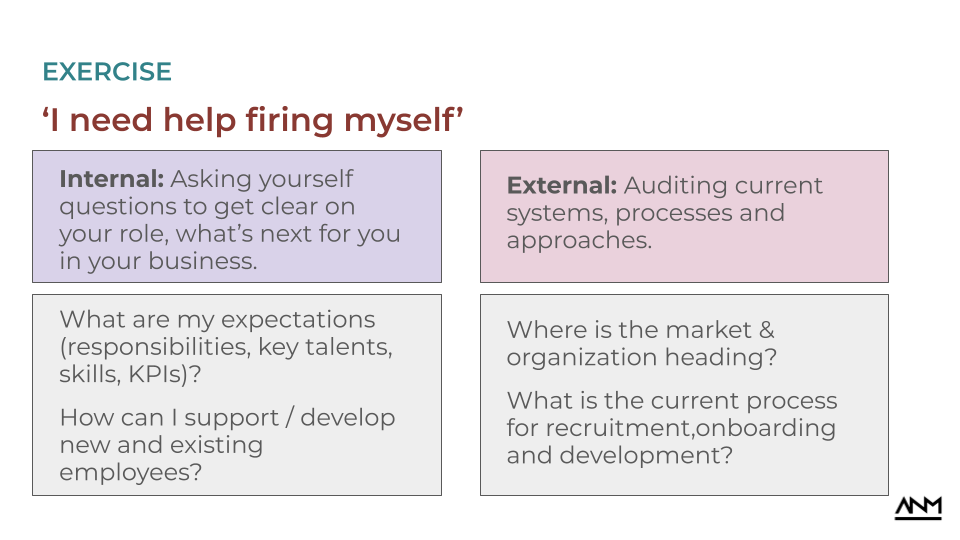How to 'Fire Yourself' Strategically: Succession Planning First Steps

Imagine you're the CEO of a rapidly growing startup, and you've arrived at a crossroads. You've realized the critical need to step back from the daily operations and find a successor who can not only maintain but also elevate your company's trajectory. Yet, your journey has been a rollercoaster, with several potential successors who didn't quite fit the bill. Now, you're determined to ensure that the next one sticks.
Though there is no one right next step, I think there is a better one. Considering that research from the Corporate Executive Board (CEB) estimates that 50% to 70% of executives fail within 18 months, as the CEO, you would start by:
Trying to find your 'clone.'
Reflecting on your current recruitment and onboarding process.
Getting very clear on where your business is going next.
Hiring someone with more experience.
Other
This blog post focuses on the critical first steps you should take to ensure you're building processes that will support your business into the future, not just where it is right now (#3).

Image: Summary slide of the types of questions you can ask yourself when approaching this situation.
Focus on future potential challenges, not just what keeps you up at night now.
Even before you reach out to recruiters and build a hiring process, you cannot 'fire yourself' until you are clear on what you are looking for and where your business is going.
Clarify Your Vision: Where Is Your Business Going?
To replace yourself, you must first have a clear vision of where you want your business to be. Define your long-term goals, mission, and values. Consider market trends, emerging technologies, and potential disruptions. The recruited leader should align with this vision and be capable of leading your company in that direction.
For example, consider a fictional startup, "TechSavvy Solutions." The founder envisions TechSavvy as a leader in green technology. The ideal successor must share this commitment to sustainability and would hopefully have a track record of leading companies in eco-friendly innovation.
Real World Example: For example, take the case of Tim Cook succeeding Steve Jobs at Apple. Cook focused on operational excellence and global expansion, ensuring Apple's continued growth while staying true to its innovative DNA.
Identify Core Competencies for Future Success
Take a close look at your business's core competencies. What will drive success in the future? Consider the skills, knowledge, and experiences your replacement will need to navigate the evolving landscape. Don't just hire for today; hire for the skills that will drive your business forward tomorrow.
Imagine a hypothetical company, "InnoTech Inc." They foresee a future dominated by AI and automation. To thrive, they seek a successor with a deep understanding of AI and a history of implementing automation solutions in similar industries.
Real World Example: Think about how Sundar Pichai, when becoming Google's CEO, emphasized the importance of artificial intelligence (AI) and machine learning, aligning Google's direction with the future of technology.
Resist the urge to clone yourself.
You (and your current skills and competitive edge) might not be what your business needs moving forward.
Consider "GlobalGrowth Enterprises," where the founder has a strong finance background. To diversify into new markets, they choose a successor skilled in international expansion, even though their strengths differ.
Real World Example: Consider how Warren Buffett's successor, Ajit Jain, brought a deep understanding of insurance to Berkshire Hathaway, complementing Buffett's investment prowess.
Assess Current Leadership Gaps
Conduct an honest assessment of your current leadership team, if you have one, and your strengths and weaknesses. Identify the gaps that need to be filled to achieve your future vision. This analysis will help you determine the specific qualities and expertise your replacement should possess.
In the fictional company "MarketPulse Innovations," a leadership gap analysis reveals a need for stronger customer-centric leadership. The CEO decides to prioritize hiring a successor with a proven record in improving customer experiences.
Real World Example: Take, for instance, how Satya Nadella became Microsoft's CEO and recognized the need for cultural change. He successfully pivoted the company towards a cloud-first strategy, aligning Microsoft with emerging industry trends.
Determine the role YOU will play in setting them up for success.
Your work doesn't end with the hiring decision. It's crucial to understand the role you'll play during recruitment and onboarding to support a seamless transition. Leadership success begins with self-awareness. Reflect on your beliefs, assumptions, and internal narratives to identify any biases or limitations that might hinder your ability to cultivate effective successors.
'Firing yourself' is a strategic move that requires careful planning and consideration before hiring or building processes.
Before you consider recruiting or finalizing a future-focused job description, build a clear vision of where your business is headed, identify core competencies, and assess current leadership gaps, including your own. By taking these critical first steps, you'll set the foundation for finding the right leaders (or leaders) who can help your business or department thrive in an ever-changing landscape.

Eager to delve deeper into leadership and people-related topics and want to learn from other experienced leaders? Attend the next #PeopleBeforestrategy Roundtable. Join us to gain more insights and hear practical advice to achieve long-term success in your business and career.
Related Resources
Case Study: Recruiting, Hiring, and Training a New Team
3 Things I Kept In Mind While Building A Team From Scratch
The True Price of Losing an Employee (There are SEVEN costs)
The Top 6 Limiting Beliefs That Sabotage Successful Delegation
This blog post was co-created with the help of AI tools.
Leaders aren't born; they're made.
This 5-minute assessment will help you understand what leadership stage you're currently in so you can determine your next steps.
© Copyright 2023, Akua Nyame-Mensah | Terms & Conditions | Website by Rachelle Deem


0 comments
Leave a comment